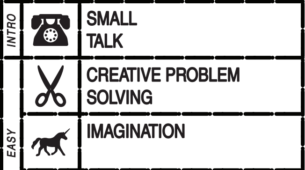Yesterday afternoon, I played Tee K.O. with a few friends of mine from CS247G, a game included in The Jackbox Party Pack 3. Tee K.O. is an excellent example of a judging game, as it involves a group of 3–8 players submitting something to the group (text, an image, or some combination of the two) and voting on which submission made them laugh the most. It was a little awkward to play around 3pm because we were all more used to playing these games at night and (admittedly) slightly inebriated. However, we gave both games a good faith effort and if anything the drier environment allowed us to focus on the games as designers and developers rather than as players.
Through this experience, I realized I approach Jackbox games (and judging games in general) by relying heavily on inside jokes, as I typically play these games with my close friends and very rarely with strangers. Although this is largely due to my approach to comedy as a whole, there are mechanics within the games we played that strongly encourage this kind of behavior from the players. These mechanics result in dynamics that bring players closer together, but unfortunately run the risk of alienating players not in the in-group.
For those unfamiliar with Tee K.O., the general steps of the game are: 1) make 3 drawings that each have a 90 second time limit, 2) make as many funny captions as you can under a shorter time limit, 3) submit a pairing of a caption with a drawing onto a t-shirt, and 4) vote on which shirt is the funniest. We decided to play Tee K.O. first because we felt it encapsulated multiple aspects of the judging game genre, as multiple things are being judged at once, namely: 1) the subject chosen for the art, 2) the quality of the art, 3) the comedic value of the caption, and 4) the comedic harmony (or dissonance) between the caption and the art on the shirt.
As soon as we started playing, it was apparent to me that all our submissions would be related to inside jokes that wouldn’t have even made sense 10 minutes prior to setting up the game. As he walked in, one of the players, who lives in GovCo (west campus), mentioned how he feels like Lief Erikson (Norse explorer) every time he makes the arduous, month-long trek to EVGR (where we hosted the game). Naturally, the rest of us took this comment and ran with it, making drawings and captions referencing his travels, Lief Erikson, and the general absurdity of GovCo’s distance from the rest of campus. To a person unfamiliar with any of these themes, the drawings would have been inane and meaningless, but to us they were hilarious and often won in the voting sections of the game.
This was not for a lack of trying on our parts to keep the images from being solely related to inside jokes. In a personal effort to avoid using this kind of comedy as a crutch, I used the “suggestion” button included at the bottom of both the drawing and writing sections of the game to guide my design of an image and caption, respectively, to see what kinds of things the developers had in mind when approaching drawing or writing. The drawing suggestion I got was “a romantic person” and the writing suggestion was “a line you’d see on a fortune cookie.” Needless to say, despite drawing and writing for these prompts, neither were ever picked for a shirt because neither really made sense to us the players within the context of the game and our relationships with each other. The quality of the suggestions discourage people from using them and exploring different kinds of drawings, leading to the reliance on inside jokes for the shirt designs.
Unfortunately, this reliance on inside jokes for comedy can be to the detriment of players’ experiences. Since I typically play Tee K.O. with folks that are in similar fandom and gaming spaces as I’m in, there are certain inside jokes and references that I’ll occasionally make in the game that rely on knowledge of these spaces. For example, sometimes if I’m struggling to come up with a drawing (because let’s face it, 4 drawings at 90 seconds apiece can be a little exhausting), I’ll just crudely draw a picture of Sans from UNDERTALE, as most people in these spaces are at least aware of the character. However, on this occasion, one of the players had no idea who Sans was and so when it came time to vote on the shirts, they had no clue why we were laughing at a crudely drawn skeleton man with a blue hoodie and basketball shorts. I could tell by the player’s body language that they were uncomfortable with the fact that they didn’t recognize the character and had to interrupt our laughter to ask who it was. If we weren’t as good of friends with this player, this experience could have discouraged them from playing Jackbox games with us again entirely.
Ultimately, the dynamics engendered in Tee K.O. encourage heavy use of inside jokes that don’t require much thought or explanation from the players and allow for faster, punchier, and funnier gameplay for groups of people that know each other incredibly well. However, even if one person isn’t in on the joke, it could damage their experience and discourage them from playing an otherwise fun game with their friends just because they don’t want to feel the embarrassment of not being in the in-group.
This dynamic brings into play important ethical questions regarding whose responsibility it is to make sure everyone enjoys themselves while playing games such as Tee K.O. Although I believe much of the responsibility lies on the players to make sure their responses are accessible to all those in their group, there are ways we as developers can improve game mechanics to make people less bad about losing, not understanding a joke, or not knowing what to draw or write.
One example of this is the animation that plays at the end of each voting session. While the winning shirt simply gets text at the top reading “WINNER,” the losing shirt gets torn to shreds and burnt to a crisp. Though a funny visual, for a player that has yet to win a single vote over multiple rounds this animation could be incredibly discouraging. Although I have yet to think of a good fix for this aspect of the game, I would hope a future iteration of Tee K.O. would keep this in mind and find a gentler way to show shirts winning over other shirts.







